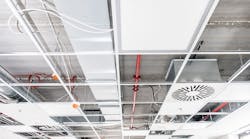Whether situated above a drop ceiling in a hospital, below an elevated data center floor or concealing network wires and cables in a conference venue, plenum areas are typically hidden from view. But materials operating behind the scenes in a building certainly demand center stage attention when it comes to life safety.
These unseen areas where oxygen-rich air circulates are used to store networks of plastic-coated mechanical pipes and cabling. Ample oxygen can serve as food for a fire and help it spread throughout a space. As fire contacts combustible materials, toxins produced from melting cables present additional concerns.
The risk presented by the plenum space is acknowledged in today’s building codes. Following tragic fires, building codes were adapted to address concerns related to both electrical and mechanical systems in buildings. Local building codes provide governance on the type, approval and placement of cables and devices within plenum spaces. Local code bodies adopt various fire safety codes established by the National Fire Protection Association (NFPA).
Plenum spaces can vary in location within a facility. Common locations for plenums include mechanical spaces in hospitals, manufacturing plants and universities. PVC piping systems that manage mechanical processes as well as the pipe insulation used on these systems should be considered when specifying materials used to insulate pipes.
Conversations about plenum spaces and materials have focused extensively on electrical codes and the toxicity risk associated with combustible materials—such as cables in the plenum. However, the plastic-coated pipes commonly used in mechanical systems should also be taken into account when considering materials for the plenum.
Following large fires, including a 1975 World Trade Center fire, listing agencies, such as Underwriters Laboratories (UL), created replicable tests based on standards for buildings’ plenum spaces. The new tests preceded several changes to the International Building Code and the International Mechanical Code. Below, we look at specific areas of code related to combustible materials used in the plenum.
[Related: 5 Best Practices for Designing Better Ceilings]
International Mechanical Codes and Pipes in the Plenum Space
Section 602.2.1 of the 2012, 2015 and 2018 International Mechanical Code specify the materials that may be used in plenum spaces—including the plenum’s mechanical pipes. Recent adaptations to the code specify that insulation installed on combustible material in the plenum must be listed and labeled to have a flame spread index not more than 25 and a smoke developed index not more than 50 when tested in accordance with ASTM E84 or UL 723. Exception #5, however, provides an exception that applies to combustibles fully enclosed within the following: 5.3 Material listed and labeled for installation within a plenum.
ASTM E84 Standard Test Method for Surface Burning of Building Materials or UL 723 Standard for Test for Surface Burning Characteristics of Building Materials are “reaction to fire” test standards. These methods measure the flame spread and amount of smoke produced by the materials used. These methods do not measure the hourly fire resistance.
Instead, hourly fire resistance ratings are determined when building elements or assemblies are tested according to ASTM E 119 Standard Test Methods for Fire Tests of Building Construction and Materials or UL 263 Standard Fire Tests of Building Construction and Materials. These testing standards are used to determine fire-resistance ratings. These tests are entirely different from the ASTM E84 and UL 723 test methods. Whereas ASTM E119 and UL 263 measure hourly fire resistance, ASTM E84 and UL 723 measure reaction to fire.
Building materials located in plenum areas—including insulation and plenum wrap used to wrap piping—should fully comply with a listing organization, such as UL. At a minimum, materials should comply with the listing organization’s requirements for covering materials on insulated plastic pipe assemblies as set by the building code.
[Related: Strategies for Conquering Workplace Acoustical Issues]
Additional Considerations for Plenums: Appearance and Sanitation
Protecting lives will always be the top priority when specifying and installing building materials in the plenum area. However, evaluating the specifics of the environment may influence material choice, especially with regards to the materials protecting pipes. How easy is a material to use on the job site and in the tight workings of the plenum area? What kind of maintenance is required?
As plenums are often difficult to access and limit a worker’s ability to move about, the insulating material used on pipes should be light and sized for easy handling. Plenum wrap is one choice for insulating pipes that conforms with non-combustibility requirements. But within such a small and confined space, plenum wrap can be challenging to wrap around pipes of varying sizes and tucked into small spaces. Given these challenges, building materials that will remain intact and not require re-sealing may help to reduce callbacks.
Following the global pandemic and subsequent efforts to increase hygiene practices, buildings of all types are seeking materials that can easily be wiped down. A material’s surface should be able to withstand regular maintenance and cleaning/sanitizing procedures. When evaluating the jacketing used on mechanical pipes, thermal and moisture resistance are important criteria. However, it is also important to take into account how easily a material is to clean and maintain. Choosing an insulation with a polymer jacketing surface will allow it to be wiped down as part of regular cleaning efforts.
Building and fire codes are in place to support life safety in the plenum. Protecting human life and safety will always be the most important goals when specifying materials. But other considerations including a material’s ease of install and the opportunity to address other challenges such as the sanitation of the space and clean appearance—should also come into play when selecting materials. While the networks of piping that reside in the plenum may be located away from the line of sight, selecting materials that protect these pipes should be given a thorough overview.
About the Author:
Dick Gebhart is a technical manager for Owens Corning.
Read next: This Houston Clinic Addresses Healthcare Disparities with Smart Design



